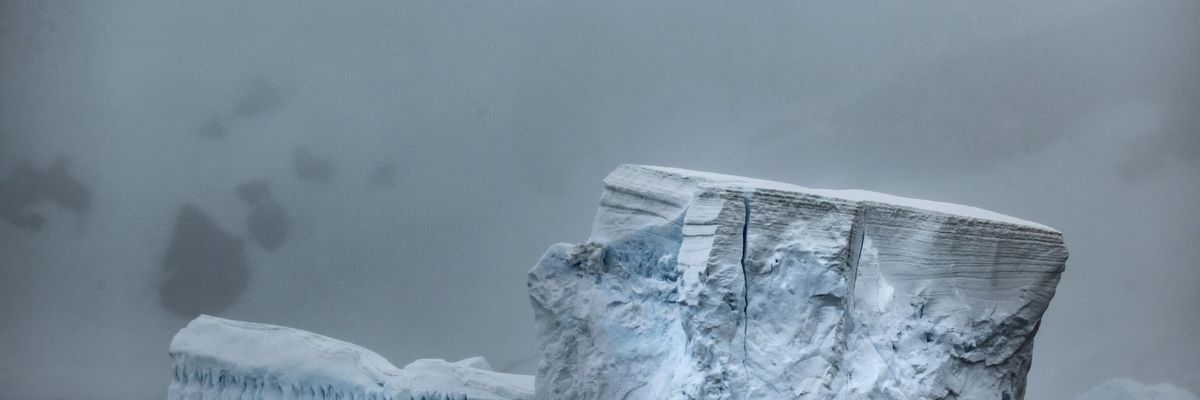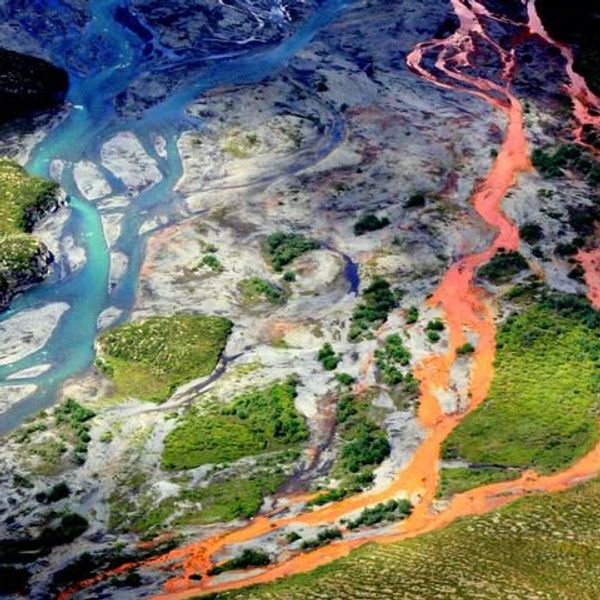
Glaciers are seen as ice floes melt in Antarctica on February 7, 2022. (Photo: Sebnem Coskun/Anadolu Agency via Getty Images)
Rapidly Retreating Doomsday Glacier Clinging 'By Its Fingernails': Study
"Just a small kick to Thwaites could lead to a big response," warned the lead author of an alarming new analysis.
New research unveiled Monday suggests that the West Antarctic Thwaites Glacier--an enormous ice mass with the potential to trigger catastrophic sea level rise--could retreat far more quickly in the coming years than scientists previously anticipated as fossil fuel-driven planetary warming continues to accelerate.
"We should expect to see big changes over small timescales in the future--even from one year to the next."
Dubbed the "Doomsday Glacier," Thwaites has been the subject of scientific concern for decades given its immensity--it is roughly the size of the U.S. state of Florida and, if melting continues at the current pace, it could raise global sea levels by 11 feet or more.
But a new study published in Nature Geoscience offers a first-of-its-kind look at the body's transformation over time, finding that "sustained pulses of rapid retreat have occurred at Thwaites Glacier in the past two centuries."
"Over a duration of 5.5 months, Thwaites' grounding zone retreated at a rate of >2.1 km per year--twice the rate observed by satellite at the fastest retreating part of the grounding zone between 2011 and 2019," the analysis notes. "Similar rapid retreat pulses are likely to occur in the near future when the grounding zone migrates back off stabilizing high points on the sea floor."
Robert Larter, a marine geophysicist with the British Antarctic Survey, said Monday that the research shows Thwaites "is really holding on today by its fingernails, and we should expect to see big changes over small timescales in the future--even from one year to the next--once the glacier retreats beyond a shallow ridge in its bed."
Related Content

'Really, Really Bad': Scientists Raise Alarm Over Warm Ocean Water Beneath 'Doomsday Glacier' in Antarctica
To explore past changes to the glacier and help chart out its possible future, a team of scientists led by Alastair Graham of the University of South Florida's College of Marine Science traveled to West Antarctica to observe the sea floor in front of Thwaites using a sensor-equipped autonomous submarine.
"Over two extended survey missions, we targeted submarine troughs previously hypothesized as conduits for warm water access to the glacier grounding line," Graham and study co-authors Lauren Simkins and Anna Wahlin wrote in a summary of their expedition. "At both sites, the sea-floor also comprised of sills that likely served as former stabilizing points for the grounding zone of Thwaites. "
"For Thwaites, the importance of our results lies in two take-home messages. The first is that Thwaites has undergone significantly faster rates of retreat in the past than it is experiencing right now," they continued. "This finding raises the potential upper 'speed limit' on our expectations for Thwaites behavior in the near future."
"Second, our results show that very short (several months duration) pulses of non-linear grounding zone retreat occur, especially where the ice is retreating from flattish sea floors or flat-topped ridges," they added. "These phases of rapid retreat are corroborated by modern observations, and demonstrate, collectively, that drastic changes in grounding line position might be expected, even from one field season to the next."
In a statement, Graham warned that "just a small kick to Thwaites could lead to a big response." Researchers have cautioned that several feet of global sea level rise could have devastating consequences, displacing tens of millions of people.
Tom Frazer, dean of the University of South Florida's College of Marine Science, said that just because the glacier is "out of sight, we can't have Thwaites out of mind."
"This study is an important step forward in providing essential information to inform global planning efforts," Frazer added.
An Urgent Message From Our Co-Founder
Dear Common Dreams reader, The U.S. is on a fast track to authoritarianism like nothing I've ever seen. Meanwhile, corporate news outlets are utterly capitulating to Trump, twisting their coverage to avoid drawing his ire while lining up to stuff cash in his pockets. That's why I believe that Common Dreams is doing the best and most consequential reporting that we've ever done. Our small but mighty team is a progressive reporting powerhouse, covering the news every day that the corporate media never will. Our mission has always been simple: To inform. To inspire. And to ignite change for the common good. Now here's the key piece that I want all our readers to understand: None of this would be possible without your financial support. That's not just some fundraising cliche. It's the absolute and literal truth. We don't accept corporate advertising and never will. We don't have a paywall because we don't think people should be blocked from critical news based on their ability to pay. Everything we do is funded by the donations of readers like you. Will you donate now to help power the nonprofit, independent reporting of Common Dreams? Thank you for being a vital member of our community. Together, we can keep independent journalism alive when it’s needed most. - Craig Brown, Co-founder |
New research unveiled Monday suggests that the West Antarctic Thwaites Glacier--an enormous ice mass with the potential to trigger catastrophic sea level rise--could retreat far more quickly in the coming years than scientists previously anticipated as fossil fuel-driven planetary warming continues to accelerate.
"We should expect to see big changes over small timescales in the future--even from one year to the next."
Dubbed the "Doomsday Glacier," Thwaites has been the subject of scientific concern for decades given its immensity--it is roughly the size of the U.S. state of Florida and, if melting continues at the current pace, it could raise global sea levels by 11 feet or more.
But a new study published in Nature Geoscience offers a first-of-its-kind look at the body's transformation over time, finding that "sustained pulses of rapid retreat have occurred at Thwaites Glacier in the past two centuries."
"Over a duration of 5.5 months, Thwaites' grounding zone retreated at a rate of >2.1 km per year--twice the rate observed by satellite at the fastest retreating part of the grounding zone between 2011 and 2019," the analysis notes. "Similar rapid retreat pulses are likely to occur in the near future when the grounding zone migrates back off stabilizing high points on the sea floor."
Robert Larter, a marine geophysicist with the British Antarctic Survey, said Monday that the research shows Thwaites "is really holding on today by its fingernails, and we should expect to see big changes over small timescales in the future--even from one year to the next--once the glacier retreats beyond a shallow ridge in its bed."
Related Content

'Really, Really Bad': Scientists Raise Alarm Over Warm Ocean Water Beneath 'Doomsday Glacier' in Antarctica
To explore past changes to the glacier and help chart out its possible future, a team of scientists led by Alastair Graham of the University of South Florida's College of Marine Science traveled to West Antarctica to observe the sea floor in front of Thwaites using a sensor-equipped autonomous submarine.
"Over two extended survey missions, we targeted submarine troughs previously hypothesized as conduits for warm water access to the glacier grounding line," Graham and study co-authors Lauren Simkins and Anna Wahlin wrote in a summary of their expedition. "At both sites, the sea-floor also comprised of sills that likely served as former stabilizing points for the grounding zone of Thwaites. "
"For Thwaites, the importance of our results lies in two take-home messages. The first is that Thwaites has undergone significantly faster rates of retreat in the past than it is experiencing right now," they continued. "This finding raises the potential upper 'speed limit' on our expectations for Thwaites behavior in the near future."
"Second, our results show that very short (several months duration) pulses of non-linear grounding zone retreat occur, especially where the ice is retreating from flattish sea floors or flat-topped ridges," they added. "These phases of rapid retreat are corroborated by modern observations, and demonstrate, collectively, that drastic changes in grounding line position might be expected, even from one field season to the next."
In a statement, Graham warned that "just a small kick to Thwaites could lead to a big response." Researchers have cautioned that several feet of global sea level rise could have devastating consequences, displacing tens of millions of people.
Tom Frazer, dean of the University of South Florida's College of Marine Science, said that just because the glacier is "out of sight, we can't have Thwaites out of mind."
"This study is an important step forward in providing essential information to inform global planning efforts," Frazer added.
New research unveiled Monday suggests that the West Antarctic Thwaites Glacier--an enormous ice mass with the potential to trigger catastrophic sea level rise--could retreat far more quickly in the coming years than scientists previously anticipated as fossil fuel-driven planetary warming continues to accelerate.
"We should expect to see big changes over small timescales in the future--even from one year to the next."
Dubbed the "Doomsday Glacier," Thwaites has been the subject of scientific concern for decades given its immensity--it is roughly the size of the U.S. state of Florida and, if melting continues at the current pace, it could raise global sea levels by 11 feet or more.
But a new study published in Nature Geoscience offers a first-of-its-kind look at the body's transformation over time, finding that "sustained pulses of rapid retreat have occurred at Thwaites Glacier in the past two centuries."
"Over a duration of 5.5 months, Thwaites' grounding zone retreated at a rate of >2.1 km per year--twice the rate observed by satellite at the fastest retreating part of the grounding zone between 2011 and 2019," the analysis notes. "Similar rapid retreat pulses are likely to occur in the near future when the grounding zone migrates back off stabilizing high points on the sea floor."
Robert Larter, a marine geophysicist with the British Antarctic Survey, said Monday that the research shows Thwaites "is really holding on today by its fingernails, and we should expect to see big changes over small timescales in the future--even from one year to the next--once the glacier retreats beyond a shallow ridge in its bed."
Related Content

'Really, Really Bad': Scientists Raise Alarm Over Warm Ocean Water Beneath 'Doomsday Glacier' in Antarctica
To explore past changes to the glacier and help chart out its possible future, a team of scientists led by Alastair Graham of the University of South Florida's College of Marine Science traveled to West Antarctica to observe the sea floor in front of Thwaites using a sensor-equipped autonomous submarine.
"Over two extended survey missions, we targeted submarine troughs previously hypothesized as conduits for warm water access to the glacier grounding line," Graham and study co-authors Lauren Simkins and Anna Wahlin wrote in a summary of their expedition. "At both sites, the sea-floor also comprised of sills that likely served as former stabilizing points for the grounding zone of Thwaites. "
"For Thwaites, the importance of our results lies in two take-home messages. The first is that Thwaites has undergone significantly faster rates of retreat in the past than it is experiencing right now," they continued. "This finding raises the potential upper 'speed limit' on our expectations for Thwaites behavior in the near future."
"Second, our results show that very short (several months duration) pulses of non-linear grounding zone retreat occur, especially where the ice is retreating from flattish sea floors or flat-topped ridges," they added. "These phases of rapid retreat are corroborated by modern observations, and demonstrate, collectively, that drastic changes in grounding line position might be expected, even from one field season to the next."
In a statement, Graham warned that "just a small kick to Thwaites could lead to a big response." Researchers have cautioned that several feet of global sea level rise could have devastating consequences, displacing tens of millions of people.
Tom Frazer, dean of the University of South Florida's College of Marine Science, said that just because the glacier is "out of sight, we can't have Thwaites out of mind."
"This study is an important step forward in providing essential information to inform global planning efforts," Frazer added.

